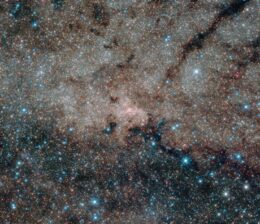Sometimes, stars and black holes can happily coexist. Other times, the star gets ripped apart. In a recent research article, a team explored what can happen in between those two extremes.
Challenging Companions

Dense star clusters, like the Milky Way’s nuclear star cluster depicted at the center of this image, provide opportunities for black holes and stars to get dangerously close. [NASA, ESA, and the Hubble Heritage Team (STScI/AURA)]
When stars and black holes meet, it can be spectacular: a black hole’s tidal forces can pull apart a star, resulting in a tidal disruption event that powers bright emission across the electromagnetic spectrum. Tidal disruption events can fully or partially disrupt a star, and they can occur around supermassive or stellar-mass black holes (the latter events are called micro tidal disruption events). Tidal disruption events take place when stars approach black holes on parabolic or highly elliptical orbits — what happens when the star’s orbit is nearly circular, instead?
Tidal Peeling Events
Chengcheng Xin (Columbia University) and collaborators used smoothed-particle hydrodynamics simulations to model the interaction between a star and a black hole in a close binary system. They modeled 96 combinations of starting parameters, changing the eccentricity of the system from a perfect circle to a slightly squashed one, varying the mass of the star from 1 to 15 solar masses, and exploring different values of the penetration factor: the ratio between 1) the distance from the black hole at which an object would be tidally disrupted and 2) the pericenter distance.

Example of the spiral gas structure created in a tidal peeling event. [Adapted from Xin et al. 2024]
A New Kind of Transient Phenomenon?
From our distant vantage point, would we be able to distinguish a tidal peeling event from a micro tidal disruption event? Both phenomena exhibit intense electromagnetic radiation powered by accretion of stellar gas onto a black hole. The rates of accretion are similar between tidal peeling events and micro tidal disruption events, but their timescales and time evolution are different. Tidally peeled stars are stripped apart over the course of several short orbits — likely a few to a few tens of hours — while micro tidal disruption events can be slower to play out.
As this study is an initial exploration of tidal peeling events, there is still much to learn about their physical and observational characteristics. Future avenues for investigation include the impact of outflowing jets and winds, shocks that form when the star collides with its own tidal debris, and what changes might arise when simulations are started sooner, long before the star and the black hole are already positioned close together and poised for the peeling to begin.
Citation
“‘Tidal Peeling Events’: Low-eccentricity Tidal Disruption of a Star by a Stellar-mass Black Hole,” Chengcheng Xin et al 2024 ApJ 961 149. doi:10.3847/1538-4357/ad11d3

